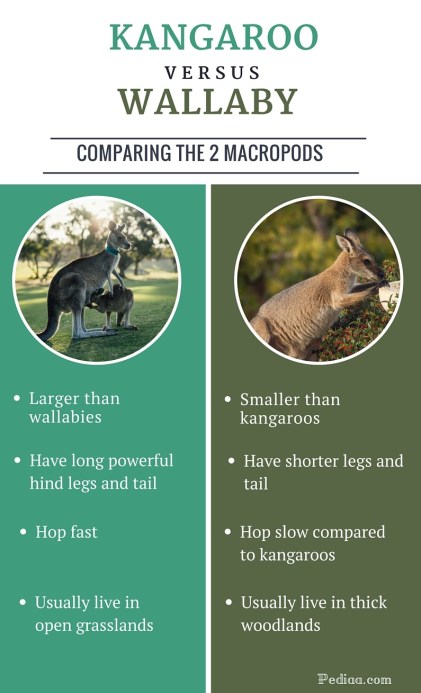Main Difference – Kangaroo vs Wallaby
Mammals are the most advanced group of animals that currently dominates the earth. Even among mammals, some groups are extraordinary due to some unique features that cannot be found in other mammalian genera. Mammals are classified broadly into three groups; Monotremes, Marsupials and placental mammals. Monotremes are the egg-laying mammals classified under subclass Prototheria. Duck-billed platypus and two echidna species are the only monotremes living today. Marsupials are well known as pouched mammals due to the presence of marsupial pouch in which their young are raised. Both kangaroo and wallabies belong to this group. Kangaroo and wallaby belong to the superfamily Macropodoidea, which also include pademelons, tree kangaroos and rat kangaroos. They are commonly referred to as macropods. These creatures are found nowhere else in the world except in Australia and New Guinea. Macropods are well-known for their larger hind limbs and powerful tails, which are used for balance while hopping. Kangaroo and wallaby look very similar and often belong to same genera. The main difference between kangaroo and wallaby is their size; the term wallaby is just a non-scientific term often used for smaller size kangaroos. Both kangaroos and wallabies are herbivores, feeding on grass and roots. They are mostly active at night. There are about 45 species of both kangaroos and wallabies. Male kangaroos or wallabies are called bucks, boomers or jacks, and females are called does, flyers, or jills. The term ‘joeys’ is used for young of both kangaroos and wallabies.
Kangaroo – Facts, Characteristics, and Behaviour
The term Kangaroo usually refer to larger sized macropods in the superfamily Macropodoidea. The term ‘wallaroo’ is used for medium sized members of the same family, and the term ‘wallaby’ is used for smaller sized members. They are endemic to Australia. Kangaroos have large, powerful hind legs adapted for leaping and hopping. Their powerful muscular tail helps them to keep the balance while leaping and hopping. Female kangaroos have a pouch known as marsupium, in which postnatal development of young takes place. The largest living species is the red kangaroo. An adult male red kangaroo can reach up to 2m tall and weigh up to 90 kg. Males are larger than females.

Wallaby – Facts, Characteristics, and Behaviour
Wallabies are the smaller sized kangaroos in the superfamily Macropodoidea. Wallabies have smaller and stockier bodies with smaller hind legs and a shorter tail when compared with kangaroos. Because of the less powerful hind legs, wallabies hop slower than kangaroos. Wallabies are usually found in thicker woodlands. Some examples for Wallabies include; agile wallaby, whiptail wallaby, red-naked wallaby, etc.

Difference Between Kangaroo and Wallaby
Body size
Kangaroos are larger than wallabies.
Wallabies are smaller than kangaroos.
Size of Hind Legs and Tails
Kangaroos have much powerful long hind legs and tails than wallabies.
Wallabies‘ legs and tails are smaller and less powerful.
Habitats
Kangaroos usually live in open grasslands.
Wallabies usually live in thick woodlands.
Image Courtesy:
“Western grey kangaroos” by Jarrah Tree (CC BY 2.5 au) via Commons Wikimedia
“Agile Wallaby” by Glen Fergus – Own work, Cooktown, Queensland, Australia (CC BY-SA 3.0) via Commons Wikimedia
